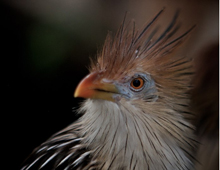Description: The Guira cuckoo is a very scruffy looking bird and sexes are very similar in appearance. The head is ochre in color, with dark streaks and an orange to rufous crest. The upper back is brown, although feathers are streaked with a white shaft and light gray edges. Both the wings and wing coverts are dark brown. The lower back is white and the rump is buff colored. The rest of the underside is ochre to whitish, with the throat and breast streaked with brown. There is featherless skin on the face that is yellow to pea green in color. Eyes and beak are yellow to orange; the legs are bluish-gray. Juveniles look very similar to adults.
Size: They have a total length of approximately 13-14 inches (34-36 cm) and weigh about five ounces (143 gr); females are slightly larger.
Behavior: These non-parasitic, social birds live in groups, with an average of six to eight birds, although as many as 20 have been recorded together. Breeding pairs preen each other and will defend their breeding territory during mating season. They do not appear to behave aggressively in the communal nest. On cold days, group members will huddle together and they roost together at night as well.
Diet: Groups will forage together for insects, frogs, eggs, large arthropods, small mammals such as mice and the nestlings of small birds.
Communication: Guira cuckoos are very noisy birds with a wide variety of noises, including yodels, guttural calls, gargled trills and whistles.
Reproduction: Nests are large platforms of sticks built high in a tree. Often a nest used in previous years will be renovated and reused. Several females will lay their eggs in the same nest. Guira cuckoos have a high rate of egg loss, as well as a high mortality rate for nestlings, due to the tossing behavior of the adults. Adults will eject eggs and young birds from the nest, although it is not fully understood why. It could be that the eggs or young are too small to be considered healthy so it is a survival tactic, or it could be that birds who did not lay or fertilize the eggs dispose of them so they can lay their own. Up to 20 eggs can be laid in a group nest. Eggs are blue to greenish-blue and are covered in white chalky splotches and streaks. The incubation period is 12-13 days and fledgling period can vary from five to six days if the young are disturbed to 12-15 days in an undisturbed nest. Parental care continues about three weeks after they fledge.
Habitat/range: The Guira cuckoo prefers drier habitats, such as second-growth scrub, scrub savannah and woodlands, pampas, pastures, fields and coastal dunes. Their range includes Bolivia, Brazil, Paraguay, Uruguay and Argentina.
Status: They are listed as least concern on the IUCN Red List.



